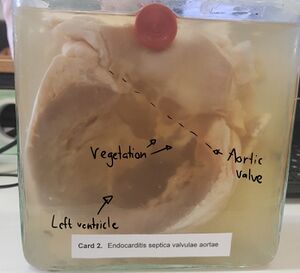44. Endocarditis septica: Difference between revisions
(Created page with "'''Organ''': Heart '''Description''': We can see some yellowish-greyish structures hanging from the aortic valve. '''Diagnosis''': Acute infective (septic) endocarditis of the aortic valve '''Causes''': * Infection by: ** Streptococcus ** Staphylococcus ** Enterococcus '''Theory''': Two types of endocarditis exist: infective and non-infective. The infective type has again two subtypes: acute and sub-acute type. The sub-acute type (also called ''endocarditis lenta...") |
(No difference)
|
Revision as of 15:09, 22 May 2022
Organ: Heart
Description:
We can see some yellowish-greyish structures hanging from the aortic valve.
Diagnosis: Acute infective (septic) endocarditis of the aortic valve
Causes:
- Infection by:
- Streptococcus
- Staphylococcus
- Enterococcus
Theory:
Two types of endocarditis exist: infective and non-infective. The infective type has again two subtypes: acute and sub-acute type.
The sub-acute type (also called endocarditis lenta) occurs in the case of unhealthy valves, most commonly in case of prosthetic valves or dystrophic calcification of the valve. The pathogen is usually streptococcus viridans. S. viridans is found on the normal oral bacterial flora. In the case of dental procedures can the bacteria enter the blood and spread to the damaged valves. Patients with unhealthy valves must therefore always receive prophylactic antibiotic treatment before dental procedures.
However, the valve in this preparation is healthy, so this is a case of acute infective endocarditis. Many types of bacteria can cause this, like streptococci, staphylococci and enterococci.
In any form of endocarditis will form vegetations on the valves. Vegetations are small growths that contain fibrin, leukocytes, RBCs, platelets and, if the endocarditis is infective, bacteria as well. Vegetations usually grow on the superior side of the valve.
The consequences of endocarditis can be divided into systemic and local. The systemic consequences can be embolization and sepsis. The local consequences can be perforation of the valve, leading to heart failure, or the bacteria can spread from the vegetation to the myocardium. This forms a phlegmone that will eventually form a characteristic type of abscess called ring abscess.

